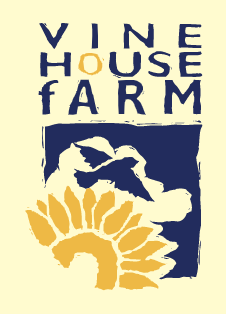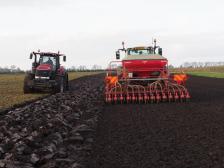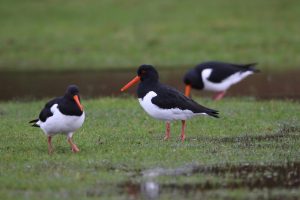
November has been a kind month with only 21.7mm or .85ins of rain. The average rainfall over the last 50 years for November is 44mm. It should be colder in the East, but our lowest temperature has only been -1°C. Overall it has been a very mild month, the average temperature being 8.75°C. Only November 1994 and 2015 were warmer.

The relatively dry month has allowed us to get all the winter wheat in the ground, something that normally happens but didn’t happen in Autumn 2019. If we are unable to sow all the winter wheat we have planned, then we have to sow spring barley in the Spring.
Robert, my son-in-law, has been costing the wheat and spring barley. There is some profit in spring barley, but it is only half what it is for winter wheat, so no wonder there are so many green fields in the winter. Of course, there are many farmers, especially in Scotland, who grow spring barley on a regular basis. They will be growing it for malting, either to make beer or whisky. Quite often you can add £40 per tonne to the price of feed barley, if the barley will make a malting sample. In general, our Fenland soil does not grow a malting sample, so when we grow barley we are stuck with the price of feed barley – which this year is £50/tonne below the price of feed wheat.
Because there was so little wheat grown last year, there is now a shortage and prices have reached an all time high of £200/tonne. For many years we have had the option of selling our wheat, barley and oil seed rape forward. That means we could choose to sell our crops a year in advance. Normally we don’t sell anything a year in front, but the high price of wheat today has dragged the price of wheat up next year to more than £160/tonne. So we are tempted to sell some of the crop that we have just planted.
The 2020 harvest was one of the worst we have known, with more barley than wheat sown. The sugar beet crop is also a very poor one this year. For the past 10 or 15 years, the seed we buy has been treated with a neonicotinoids which keeps the aphids away for 12 weeks after sowing. Now we are unable to use neonicotinoids, we were aware that aphids could come in and inject poison into the plants. They moved in earlier than expected and caught everyone by surprise and those tiny little insects have reduced the sugar beet crop in some cases by 50%. The oil seed rape was not a good crop yet again, due to not being able to use neonicotinoids to control the cabbage stem flea beetle.
Out potato crop was probably down 15% in yield, but they have a good skin finish. That means when they are washed, they look very nice and so two thirds of our crop are likely to be accepted for packing by the supermarkets. We could have sold them at a fixed price, but we decided not to as that fixed price did not show much of a profit. The other third is on contract to McCain to make chips, which show more profit than the supermarket contracts. We don’t grow all our potatoes for McCain because sometimes the price we can obtain for packing potatoes can be £100 more than the contract price. Also, as we grow on two or three different land types, some varieties of potatoes get scabby, other varieties attract slugs and no one wants potatoes with slug holes, so we have to match the variety to the field.


The last week in October and the first two weeks in November were really interesting for me to see who our winter visitors were and where they had come from. The local area was full of birds, quite a few of them have now moved on, but we still have good numbers on the farm of Blackbirds, Starlings, Chaffinches, Wood Pigeons, Fieldfares and Wigeon. Not so many Lapwings, Golden Plovers and Redwings now though.
Wood Pigeons were very late in arriving this Autumn. This we were very pleased about as when they get here, they descend on the sunflowers and can really reduce the yield. They arrived a few days after we had harvested them.
Wigeon have moved into our wetland, they are mainly graziers and they need never be more than 40 yards from water on our wetland. When they are on water they are safe from Harriers, Buzzards and Peregrines, because the Wigeon can dive under the water and so once on water the bird of prey usually goes away. Numbers are building up – probably about 800 now and 300 Teal.
In the Vine House Farm garden I have been trying to feed the Blackbirds with Ground Mix and Robin and Friends Mix, but they have not been interested, they have been busy eating the Rowan and Pyracantha berries. The only food I could tempt them with was live mealworms, out of a dish. There was definitely a pecking order and the Robin could quickly move in while a Blackbird was by the dish and thinking about something else. Then there are the Moorhens, I have about 16 that come on to my lawn now, I am feeding them on fallen apples, wheat and fat blocks spread about but there is still a bit of falling out and lots of tail flicking so there is constant movement in the garden.
We have one pond in the garden with a pair of Moorhens that had four broods, aided by a floating house, but they only reared two young. We also had a family of stoats in the garden who I believe were feeding on young Moorhens! On the pond outside of the garden, the pair only had three broods, but they have reared eight young, making 14 in total. Two more have recently arrived from elsewhere too.
Chaffinches have made a visit to the garden, but prefer to be in the yard picking up seed that we have spilt. It is a job sometimes to see what they are eating, as there isn’t much on the concrete. I haven’t seen a Brambling yet, although I understand there are a lot in Norfolk. We also have a small charm of Goldfinches that come to our Niger feeder.
Locally, one member of staff had a Mistle Thrush singing in his garden. Two White Fronted Geese, two Barnacle Geese and a Pink Footed Goose have been seen with the local Grey Lags and a lone Swallow was seen over our wetland on 27th November!
We also have about 150 Whooper Swans that have been feeding on maize stubble, but now it has been cultivated they have moved on to oilseed rape fields. Amongst them, are a few families who have kept together all the way from Iceland and they will stay together all winter and return to their breeding grounds next Spring as a family. These family parties consist of two, three or four young. When in the air Whooper Swans are continually calling to one another and that is how they keep together flying through the night, but how do they keep flying in the right direction across the sea in the night?
Mute Swans also migrate to us from eastern Europe. As the name suggests, they are mute but when flying their wings make a swooshing sound and that keeps them in touch with one another when flying. Nature had it all worked out until we came along.
The new shop and café is progressing, the windows have yet to go in, but the concrete floor of the shop has been laid and all the internal walls have been built.
Wishing all readers and customers a very Happy and safe Christmas & best wishes for 2021.



